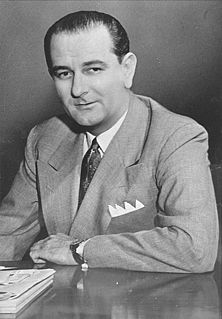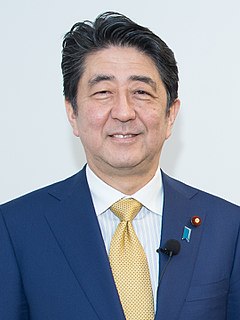
Elections to the House of Councillors, the upper house of the legislature of Japan, were held on July 11, 2004. The House of Councillors consists of 242 members who serve six-year terms. Approximately half the members are elected every three years. At these elections 121 members were elected. Of these 73 were elected from the 47 prefectural districts and 48 were elected from a nationwide list by proportional representation.

The Chief Cabinet Secretary of Japan is a Minister of State who is responsible for directing the Cabinet Secretariat of Japan. The main function of the Chief Cabinet Secretary is to coordinate the policies of ministries and agencies in the executive branch. The Chief Cabinet Secretary serves as the government's press secretary, conducts policy research, prepares materials to be discussed at cabinet meetings, and, in time of national crisis, coordinates ministries and agencies of the executive branch. The Chief Cabinet Secretary is customarily nominated as the first in line to serve as temporary Acting Prime Minister in case the Prime Minister is unable to serve due to death or other grave reasons until a new Prime Minister is appointed. The Chief Cabinet Secretary is also tasked with announcing the new era name of a succeeding emperor. The Chief Cabinet Secretary's office is located on the fifth floor of the Prime Minister's official residence in Tokyo.

The 1964 United States Senate elections coincided with the election of President Lyndon B. Johnson by an overwhelming majority, to a full term. His Democratic Party picked up a net two seats from the Republicans. As of 2019, this is the last time either party has had a two-thirds majority in the Senate, which would have hypothetically allowed the Senate Democrats to override a veto, convict and expel certain officials, or invoke cloture without any votes from Republicans. The Senate election coincided with Democratic gains in the House in the same year.

The 1962 United States Senate elections was an election for the United States Senate which was held in the middle of President John F. Kennedy's term. His Democratic Party made a net gain of three seats from the Republicans, increasing their control of the Senate.

The 1954 United States Senate elections was a midterm election in the first term of Dwight D. Eisenhower's presidency. Eisenhower's Republican party lost a net of two seats to the Democratic opposition. This small change was just enough to give Democrats control of the chamber with the support of an Independent who caucused with them.
Hino, Tokyo held a mayoral election on April 17, 2005. Incumbent mayor Baba Hiromichi won the election.
Kunio Hiramatsu was the mayor of Osaka in Japan. He was elected in 2007 with centre-left support from the Democratic Party of Japan (DPJ), People's New Party and the Social Democratic Party, defeating the centre-right supported incumbent Jun'ichi Seki by 50,000 votes.

Meguro, Tokyo held a mayoral election on April 20, 2008. Incumbent Eiji Aoki won.
Asō , also spelled Asou or Asoh, is a Japanese surname. People with this surname include:

The Osaka Restoration Association , also referred to as One Osaka, is a regional political party in Osaka Prefecture, Japan. Founded in 2010 by then-Governor Tōru Hashimoto, its main platform is pursuing the Osaka Metropolis plan of merging the prefecture and some of its cities into "One Osaka" and reducing overlapping bureaucratic organizations of Osaka Prefecture and the city of Osaka.
The 17th unified local elections in Japan took place in April 2011. In the first phase on April 10, 2011 12 governors, 41 prefectural assemblies as well as five mayors and 15 assemblies in cities designated by government ordinance were elected. In the second phase on April 24, 2011 mayors and/or assemblies in hundreds of cities, cities of Tokyo, towns and villages were up for election. Additionally, a by-election for the National Diet was held in Aichi on April 24.
The 16th unified local elections in Japan took place in April 2007. In the first phase on April 8, 2007 13 governors, 44 prefectural assemblies as well as four mayors and 15 assemblies in cities designated by government ordinance were elected. In the second phase on April 22, 2007 mayors and/or assemblies in hundreds of cities, special wards, towns and villages were up for election. Additionally, by-elections for the national Diet were held in Fukushima and Okinawa on April 22.
Events in the year 2012 in Japan.

The 23rd Elections to the House of Councillors for the upper house of the National Diet, the legislature of Japan, was held on July 21, 2013. In the last election in 2010, the Democratic Party of Japan (DPJ) remained the largest party, but the DPJ-led ruling coalition lost its majority. The House of Councillors is elected by halves to six year terms. In 2013, the class of Councillors elected in 2007 was up.
Tokyo held a gubernatorial election on April 11, 1999 as part of the 14th unified local elections. Incumbent Yukio Aoshima announced that he would not seek re-election. All major candidates ran as independents but several were supported by major parties. The Liberal Democratic Party, led by Secretary General Yoshiro Mori, supported Yasushi Akashi as a compromise with coalition partner New Komeito, but local LDP legislators divided their support between candidates Ishihara, Masuzoe and Kakizawa.

The 1812 United States elections elected the members of the 13th United States Congress. The election took place during the First Party System, and shortly after the start of the War of 1812. The Federalist Party made a relatively strong showing, winning seats in both chambers while supporting a competitive challenge to the incumbent Democratic-Republican President. However, the Democratic-Republican Party continued its control of the Presidency and both houses of Congress.

The 48th general election of members of the House of Representatives took place on 22 October 2017. Voting took place in all Representatives constituencies of Japan – 289 single-member districts and eleven proportional blocks – in order to appoint all 465 members of the House of Representatives, the lower house of the then 707-member bicameral National Diet of Japan. Incumbent Prime Minister Shinzō Abe's governing coalition of the Liberal Democratic Party (LDP) and Komeito retained their seats in light of what was perceived as weak opposition, winning his fourth term in office and holding on to the two-thirds supermajority in order to revise the war-renouncing Article 9 of the Japanese Constitution.
The first stage of the 18th unified local elections in Japan took place on April 12, 2015. The Liberal Democratic Party under leadership of Shinzo Abe was the overall victor, winning many races including all ten gubernatorial races and 1,153 of the 2,284 assembly seats at stake. Further elections for municipal mayors and assemblies took place on April 26.
Hokkaidō 2nd district was an SNTV four-member electoral district for the House of Representatives, the lower house of the National Diet of Japan, between 1947 and 1996, last used in the lower house election of 1993. Located in the prefecture (-dō) of Hokkaidō, it consisted of the cities (-shi) of Asahikawa, Rumoi, Wakkanai, Shibetsu, Nayoro, Furano and all other municipalities in the subprefectures (-shichō) Kamikawa, Sōya and Rumoi. With the return to single-member districts in the 1990s electoral reform, the district became the 7th district. In 2003 the 7th district was abolished and the area that was once the 2nd district was divided amongst the 6th, 10th and 12th districts of Hokkaidō.

The Constitutional Democratic Party of Japan , frequently abbreviated to CDP, Rikkentō (立憲党), Ritsumintō (立民党) or Minshutō (民主党), is a centre-left political party in Japan. The party is led by Yukio Edano.











